Thomas Knifton was born in 1789 at Coxbench, Derbyshire, the son of Thomas and his wife Ann (née Woodward). He was baptised at St Clement’s Church, Horsley, on Wednesday 6th May 1789. The record for his baptism shows that the family were living at ‘Tantin Cross’, an ancient name for part of Coxbench.

On Monday 22nd April 1811, Thomas married Mary Slater at St Clement’s Church. Their marriage was witnessed by Thomas’ younger sister Elizabeth Knifton and Mary’s brother John Slater.
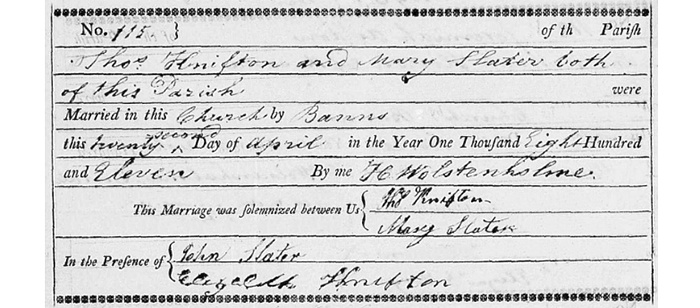
Mary was the daughter of George and Dorothy Slater of Horsley Park. She was baptised at St Clement’s Church on Saturday 16th October 1790, with the entry in the parish register recording that her parents had ‘Pd the Tax’, which was levied at 3d. per baptism.

Thomas and Mary continued to live at Coxbench, with Thomas working as a butcher. Their first child, Betty, was born at Coxbench and baptised at St Clement’s Church on 23rd October 1811. However, Betty died at the age of 5 and was buried in the churchyard at Horsley on 1st February 1817.
Their second child, John, was born at Coxbench and baptised on 5th October 1813. He was followed by Ann, baptised on 10th December 1815, George, baptised on 15th March 1818, Francis, baptised on 7th May 1821, William, baptised on 3rd April 1824, and Thomas, who was baptised on 23rd March 1827. Thomas and Mary had all of their children baptised at St Clement’s Church.
Thomas’ sister Elizabeth married John Hollingworth in March 1815 but died in February 1817 following childbirth. John remarried on 1st February 1819 at Horsley, and Thomas and Mary were asked to witness his marriage.
On 4th May 1822, Thomas took the oath of Constable for the village, a job which was rarely welcome. He may have volunteered for the position, or accepted it on a rota basis. The position was unpaid, with expenses being met out of the parish rates. ‘Tom was a shopkeeper and butcher at Coxbench, which must have kept him pretty busy. As Constable he was responsible, among other things, for the upkeep of the stocks or other methods of punishment (which every parish had); apprenticing pauper children; the collection of some types of taxes; and removing strangers and beggars. These duties were often very time consuming, for instance, it could take a whole day escorting an ‘undesirable’ back to his or her home parish. There was a widespread practice of the constable paying someone else to do these jobs, but there is no evidence or suggestion that Tom Knifton did so.’ 1
Thomas was included in Glover’s 1829 Directory of Derby under ‘Horsley, a village, township and parish in the Hundred of Morleston and Litchurch’. The ‘C’ after his name indicated that he owned his land as a copyholder, rather than as a freeholder.
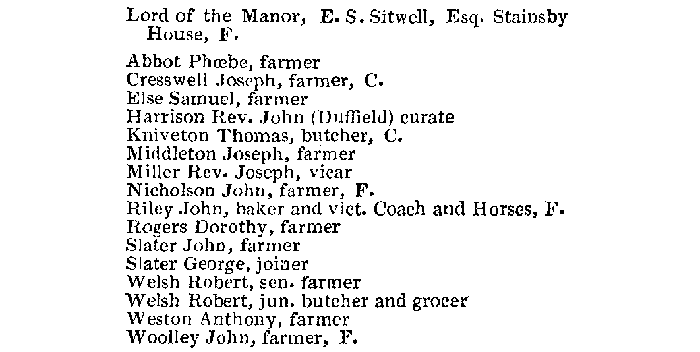 Glover’s 1829 Directory of Derby | Horsley
Glover’s 1829 Directory of Derby | Horsley
In December 1831, Thomas and Mary travelled by cart to Belper Market. Thomas was leading the horse and Mary was in the rear of the cart. During their journey, a man named Joseph Stone approached Thomas to shake his hand, pretending to know him, while at the same time another man, Henry Wright, got into the back of the cart and took 1½ lbs. of butter from Mary. During the Derbyshire Court Petty Sessions of 4th and 5th January 1832, Mary gave evidence and the men were found guilty: they were both old offenders, with Joseph Stone, aged 37, said to be ‘incorrigible’ and therefore sentenced to be transported for life, while Henry Wright, aged 20, was sentenced to 7 years imprisonment.
Thomas and Mary’s eighth and last child was named Mary. She was born at Coxbench and baptised at St Clement’s Church on 15th May 1832.
Thomas’ father died in August 1833, and by 1835 Thomas was working as a butcher and a baker. His mother Ann was a shopkeeper at the top of the hill in the village, and when she died in 1844, Thomas continued to run the grocery shop.
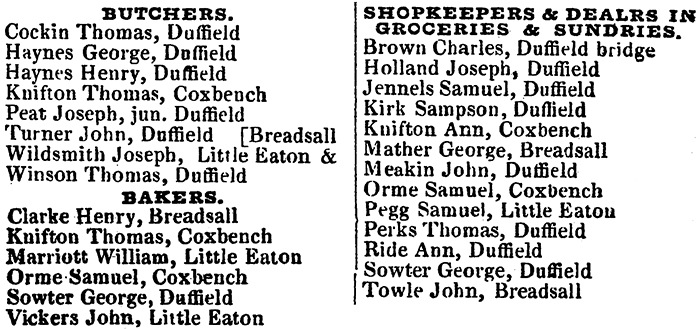 Extracts from Pigot & Co.’s 1835 Commercial Directory for Derbyshire
Extracts from Pigot & Co.’s 1835 Commercial Directory for Derbyshire
At the time of the 1841 census, Thomas and Mary were still living at Coxbench Lane, together with their children Ann, William, Thomas, and Mary.
The 1844 Tithe map of Horsley Parish shows that the family were living at Coxbench in the plot marked as number 167, described as ‘four houses gardens outbuildings &c.’. This was an area of 37 perches (936 m2), and as ‘landowner’ Thomas was required to pay 2s. 6d. tithes to the Vicar. Thomas also owned three other areas of land and premises:
- Plot 176 measuring 2 roods and 8 perches was a ‘croft’, being meadow or pasture land, which was occupied by himself, and required him to pay 1s. 3d. tithes to the Vicar.
- Plot 158 described as a ‘public house, yard, &c.’ which measured 5 perches, requiring to pay 6d. tithes to the Vicar. This pub, known as the ‘Snake Inn’ was run by his son John.
- Plot 159 described as a ‘house & garden’ of 5 perches which was occupied by John Fouke, requiring Thomas to pay 6d. tithes to the Vicar.
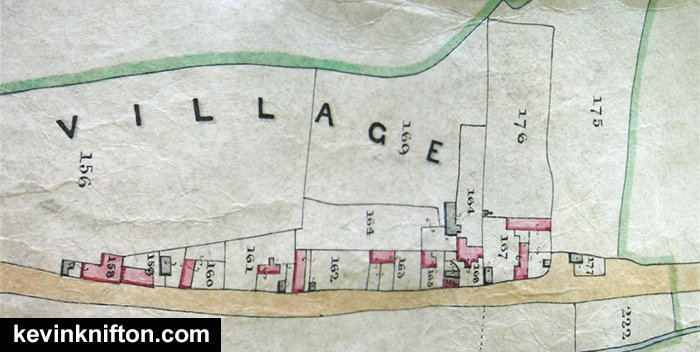 Extract from the 1844 Tithe Map of Coxbench
Extract from the 1844 Tithe Map of Coxbench
Thomas also rented a neighbouring ‘garden & cowhouse’ of 12 perches, shown as plot number 177, from Edward Degge Sitwell, and he paid 1s. tithes to the Vicar.
The buildings still stand. In 2004 the building on plot 167 fronting the road was called ‘Keepers Cottage’, and plot 177 was a garage and garden. Plot 158 was a house, while the building on plot 159 had been converted into two buildings, named ‘Quarry View’ and ‘October Cottage’.
By the time of the 1851 census, Thomas was a ‘butcher, shopkeeper, and farmer of 5 acres’ at Coxbench, and he was helped by his son Thomas who was ‘employed at home’ as a butcher. Also at the house was his wife Mary, daughter Mary, and their grandsons Francis and Samuel Knifton.
Mary died at Coxbench on 26th September 1854 aged 63. She was buried in the churchyard at Horsley on 30th September.
An entry in the diary of Thomas Needham, a resident of Horsley, reads ‘Thos. Knifton killed the old horse on the 29th of November 1855.’ Being a butcher, Thomas would have been called upon to end of the lives of old and injured animals. Another entry in 1858 reads ‘George Allreads mule was killed by Thoms. Knifton March 12th 1858.’
In 1856, the Derby Mercury reported that ‘a few friends of Mr John Radford, of Smalley, conversed upon the subject of presenting that gentleman with a testimonial as a token of gratitude for public services rendered as a justice of the peace’. It was reported that others in the local community also wanted to show their appreciation, so it was decided to receive subscriptions ‘limited to two guineas’ to pay for a portrait for which Mr Radford would sit ‘to Eddis, of London’. The list of subscribers was published in the Derby Mercury and included Thomas and his uncle William Knifton who, like most people, contributed 10s. 6d. each. The portrait was presented to John Radford on 21st October 1856 at an event in Smalley, which Thomas and William may have attended. An account of the event was recorded by Joseph Moss in his diary:
‘The nobility and gentry of the county of Derby having raised a subscription for the purpose of presenting to J. Radford Esq. a small tribute of their testimony and regard as an active and vigilant Magistrate. A committee having been formed, it was agreed that a portrait executed by an eminent artist to be the most suitable. Accordingly a pavilion was erected near Smalley Hall and the subscribers assembled and partook of a cold collation served by Mrs Cantbill of the Royal Hotel, Derby. After the cloth had been removed the chair was taken by J.W. Evans Esq. and the usual loyal toasts were given. The Chairman then addressed the meeting and presented the portrait and Mr Radford made a suitable reply. Several other speeches were given and the utmost glee and good humour prevailed. The thanks of the Chairman being given and responded to, that gentleman left the chair and the portrait was removed to its future destination. The music in attendance played at intervals. At last a dance was proposed but the committee rejected it and high words ensued amongst some of the parties, and what was all pleasant and cheerful in a few minutes became gloomy and dull. The company soon separated and some of them in not very good humour.’
Pictures of the portrait by Eden Upton Eddis can be found on the internet.
White’s 1857 Directory of Derbyshire shows Thomas residing at ‘Snake-house’ in Horsley Township. This refers to plot 158 and/or plot 159 shown on the 1844 Tithe map of Coxbench. Following the death of Thomas’ son John in 1851, the ‘Snake Inn’ pub became a beerhouse, licensed to sell beer only, not spirits, which Thomas rented out. Both the ‘Snake Inn’ and the building next door contained bread ovens in the cellars. Running a pub would not generate enough money to make a living and baking was another source of income for the family. It is here where Thomas ran his bakery business.
 White’s 1857 Directory of Derbyshire | Horsley Township
White’s 1857 Directory of Derbyshire | Horsley Township‘Those marked 4 reside at Snake-house’
By 1861 Thomas was working less as a butcher, with the census return showing that he was a ‘grocer and farmer’. His son Thomas was now the village butcher, living next-door-but-one at Coxbench Lane. Thomas’ daughter Mary was still living with him, working as the housekeeper. However, when Thomas wrote his Last Will and Testament on 30th October 1861 he still described himself as a ‘butcher and grocer’.
On 2nd May 1864, Thomas appeared at the Petty Sessions held at Smalley. The police had made checks on scales used by shops in the area. The Derby Mercury reported that ‘Superintendant Shawe summond Thomas Knifton, grocer, of Coxbench, for having in his shop, at Coxbench, on April 19th, one pair of flour scales ¼ oz. against the purchaser.’ Thomas was fined 2s. 6d. and required to pay 10s. 6d. in costs.
Following the marriage on 6th May 1863 of Thomas’ daughter Mary to her cousin Enoch Knifton, between 1864 and 1870, Thomas moved to their home at nearby Horsley Park. Here, on 4th November 1870, Thomas died aged 81. Thomas Needham, noted in his diary that ‘Old Thomas Knifton late butcher died Nov 4th 1870 aged 82 [sic] years.’
Thomas was interred on 9th November in St Clement’s Churchyard, with his wife Mary. This was also the grave where their son William was buried in 1856.
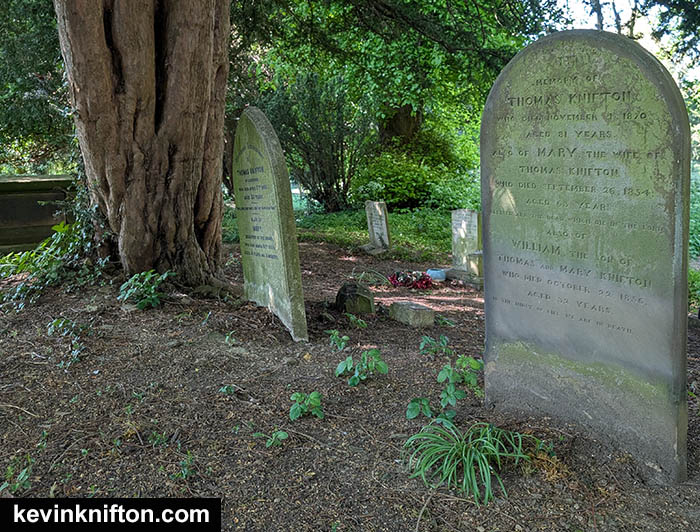 ‘In memory of THOMAS KNIFTON, who died November 4, 1870, aged 81 years. Also of MARY, the wife of Thomas Knifton, who died September 26, 1854, aged 63 years. Blessed are the dead which die in the Lord.
‘In memory of THOMAS KNIFTON, who died November 4, 1870, aged 81 years. Also of MARY, the wife of Thomas Knifton, who died September 26, 1854, aged 63 years. Blessed are the dead which die in the Lord.Also of WILLIAM, the son of Thomas and Mary Knifton who died October 22, 1856, aged 32 years. In the midst of life we are in death.’
In his Will written on 30th October 1861, Thomas bequeathed to his son Francis and daughters Ann and Mary, equal shares in ‘the four dwelling houses, croft, gardens and all the appurtenances thereto belonging’ in Coxbench Lane, which in 1861 were occupied by Ann Whelton, Thomas Annable, Thomas himself, and his son Thomas. These are shown in plot 167 on the 1844 Tithe map. To his sons Thomas and George he bequeathed equal shares in his ‘two copyhold dwelling houses gardens and appurtenances thereto belonging in Coxbench Lane’ which in 1861 were occupied by Matthew Bacon and John Fowke. These are the buildings shown in plots 158 and 159 on the Tithe map.
Thomas also wrote: ‘I devise and bequeath unto my daughters Ann Knifton and Mary Knifton the whole of my personal property...subject to them receiving and paying all my just debts and the following legacies: my sons Francis Knifton, George Knifton, and Thomas Knifton to receive each of them ten pounds. Also unto my Grandchildren, the lawful issue of my late sons John Knifton and William Knifton, ten pounds each...’
Thomas appointed his son Francis as the sole Executor of his Will, which had been signed in the presence of his son-in-law Enoch Knifton, and Joseph Cresswell.

Thomas and Mary Knifton were my great-great-great-granduncle and great-great-great-grandaunt.
1 A. Webster, Horsley Through the Ages (Oldrini Publishing, 1998), p. 47.